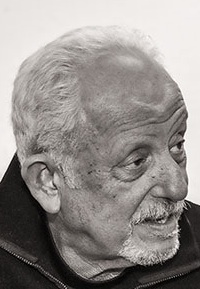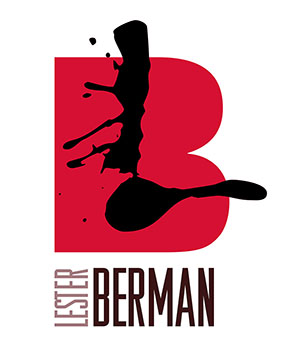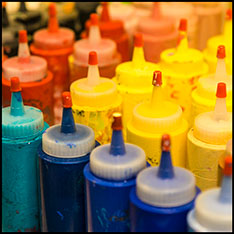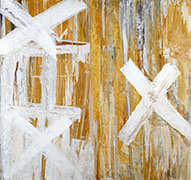The Lester Berman Story
Born in New York ...raised in the world ... steeped in the culture of creativity.
The Film Maker
 Lester Berman grew up in the Bronx in New York. “I think I was a rebellious young guy and I was always somebody who was trying to break the rules; I was expelled from school so many times for just going off and doing creative things.”
Lester Berman grew up in the Bronx in New York. “I think I was a rebellious young guy and I was always somebody who was trying to break the rules; I was expelled from school so many times for just going off and doing creative things.”
His involment in film and television started with something that–on the surface, at least–had nothing to do with movies whatsoever; PAINTING.
Twenty years ago he was putting on gallery shows as an abstract expressionist painter. Then one day, painting just wasn’t enough. “I wanted to see my paintings move, so I decided to go into graduate film school,” Berman says. So he went to New York University and got a masters in filmmaking.
The first job he landed in the film business was in Italy where he worked as a driver. He eventially became an interpreter and then moved on as an assistant director and became involved in film production.
Lester continued his international experience, filming in more than twenty countries, such as Japan, Bali and Africa. He continued to work as a line producer, and made a series of films–mostly comedies and documentaries– while still finding time to paint. But soon he realized he wanted to work on feature films.“My first job as production manager was on False Face. Where my painting and my experiance as an artist actually helped a lot with that film,” he said.
Since then, Berman has worked on more than 30 feature films in several different countries including: Brazil, Kenya, and Hungary on titles such as: Suspect Zero, The Postman and Wild Orchid, and numerous television series including: ABC’s Wildfire and Crash. All this while continuing his journey into the world of abstraction. Which brings us to Lester’s other forte...
The Art Maker
 In his travels in the United States, Mexico, Europe and Africa, Lester Berman carried a diary, in which he recorded his impressions of landscapes, architectural environs, and the people inhabiting them. These were journeys into the mind no less than into the world, for in much of what his eyes saw his imagination discovered new interior countries of his own.
In his travels in the United States, Mexico, Europe and Africa, Lester Berman carried a diary, in which he recorded his impressions of landscapes, architectural environs, and the people inhabiting them. These were journeys into the mind no less than into the world, for in much of what his eyes saw his imagination discovered new interior countries of his own.
This inner vision is molded into his painting with vital line, rich, palpable texture and a child-like abandonment. On the wall of Lester’s Albuquerque studio he has hung a quote from Baudelaire which reads “Genius is childhood, captured at will.” He elaborates his acknowledgement of Baudelaire’s observation by saying “When the paint is flowing, I am like a child, playing or dancing, often at times to primitive rhythms. If I am working well, the painting will reveal itself to me. It is not necessary to understand in order to feel.”
 Berman goes on to say “In my work, I must free myself from conditioned expectations. One cannot create new forms by following old rules. Inspiration, not rules. Personal freedom is an absolute necessity.”
Berman goes on to say “In my work, I must free myself from conditioned expectations. One cannot create new forms by following old rules. Inspiration, not rules. Personal freedom is an absolute necessity.”
To free oneself from oneself is the key to Berman’s creative concept. He sees a need for an artist “to be inside the canvas struggling to come into existance...struggling to get out–to be born.” Chance and trust are major factors of his rationale as he opens himself to the fortunes of spontaneity; “Each painting suggests itself in a new way...I must be open to receive the images that are presented to me.”
In being careful not to impose a preconceived idea of what a painting should be or how it should be composed, Berman allows a painting to occur and declares “A painting should not be logically constructed, like a computer, a building or an airplane. Precision is not the realm of the artist. An artist is not an engineer, an architect or a scientist.”
Lester Berman’s paintings are not cerebral or fixed and organized in his brain...Berman says he never knows where he’s going when he starts painting, but that everything finds his own movement. He describes his paintings as “always in motion,” and never stagnant”... much, some would say, like Lester himself.
The Artwork
 In total opposite to Berman’s creative concepts and journey, his preparations to paint are models of deliberate intent. He prefers the touch of paper to that of canvas and forgoes the use of brushes to glide, push and scrape paints across his surfaces with “matches, pins, cloths, spatulas, twigs, combs, knives, spoons and forks” because he finds brushes to have a “presence” which separates him from direct contact with his subjects.
In total opposite to Berman’s creative concepts and journey, his preparations to paint are models of deliberate intent. He prefers the touch of paper to that of canvas and forgoes the use of brushes to glide, push and scrape paints across his surfaces with “matches, pins, cloths, spatulas, twigs, combs, knives, spoons and forks” because he finds brushes to have a “presence” which separates him from direct contact with his subjects.
His character is to be precise about his materials: “I have tested and experimented on more than 70 different papers before finding the ones for me. Lately, I have been using two papers: 4-ply, 60pt. Legion Museum Board, which is 100% cotton, neutral pH and Westwind, which is 300 grams, archival, 100% rag. I apply two thin coats of acrylic gesso to the non-shiny side, letting it dry between coats. Then, I apply two separate coats of sealer on top of the two coats of gesso. This process takes several days. I then paint on the non-gessoed surface, which is absorbent and unsized.
 Berman’s penchant for precision does not end here. Ritually he works standing,
Berman’s penchant for precision does not end here. Ritually he works standing,
in scrupulously specific surroundings: “I paint on a 3/4” thick 4’x 8’ piece of plywood, 36” to 40” from the floor, slightly angled–about 25 degrees back to front. In my studio, I have from 3 to 6 of these tables set up all the time. I paint with artificial indirect light balanced to about 4,000 degrees kelvin, so that I am painting with a warmer light than daylight, which is about 5,600 degrees kelvin.
Since I’m not painting from nature, the natural blue daylight feels too cool for me.”
With these preparations, Berman has equipped himself for the hunt, as Dubuffet equated it, for art, meaning, and beauty. It is a pursuit he makes in collaboration with chance and he is more willing, in his adventure to be surprised.
Lester Berman’s paintings speak, but not to one’s consciousness; they ask questions of the viewer which cannot be heard but only sensed. In imitation of the artist’s process, they request viewers to forget that they are looking at a painting in order to feel a painting.